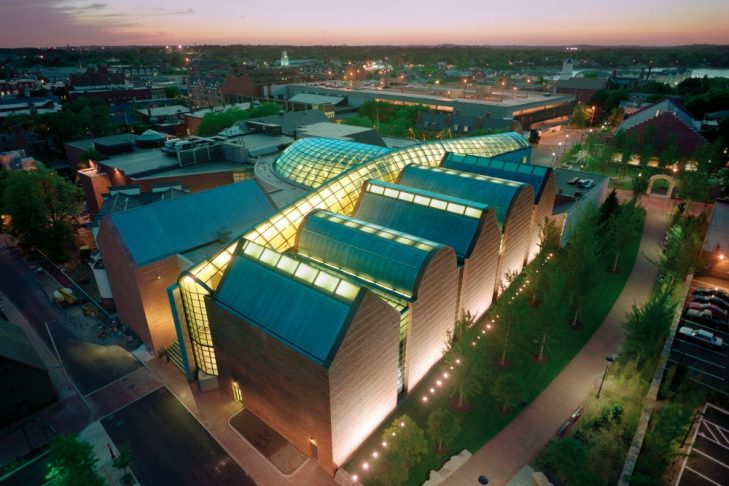Strolling through “Global Citizen: The Architecture of Moshe Safdie” at the Boston Society of Architects, one is struck by wall text in which Safdie declares: “It is inconceivable that something which is not functional should be beautiful.” The marriage of form and function in Safdie’s work is consistently evident in his sketches and the detailed models of his buildings—works of art in and of themselves.
Now 77, Safdie is arguably the most famous architect based in Boston. Born in Haifa, Israel, his wide-ranging and eclectic career was launched in 1967 when his vision of urban housing, Habitat 67, was selected to be part of Expo 67, a world exposition held in Montreal. From there his work has been realized all over the world, including notable examples in Massachusetts. Among them is the popular entry wing at the Peabody Essex Museum in Salem, with a glass-roofed atrium and row of five sky-lit galleries. He also designed the light-filled glass and brick Hebrew College campus.
Safdie grew up in Haifa until he was 15 and then moved with his family to Montreal. The son of Sephardic Jews who originally came from Aleppo, Syria, the Safdies were decidedly secular. The move to Montreal happened after the elder Safdie’s textile importing business failed. Moshe finished high school in Montreal and went on to attend McGill University, where he honed his craft as an architect. But the memory of his native Haifa, with its elegant, clean, white, three-story, Bauhaus-style apartment buildings, has clearly influenced his work. And while Safdie’s buildings are scattered across the globe, it is the many buildings he designed throughout Jerusalem that once earned him the moniker “King Herod’s successor.”

Strolling through “Global Citizen,” one can observe that Safdie’s output in Israel is both brilliant and inherent to the land. He has noted that he wants his buildings to appear “as if they had always been there.” Among his more famous edifices in Jerusalem is Yad Vashem: The World Holocaust Remembrance Center. The Boston Globe describes the Safdie design as “slic[ing] like a railroad tunnel through the top of a mountain in Israel. You absorb the horrors of the Nazi era as you pass along its length. Then when you reach the far end, it widens to a panoramic view of the sunlit Israeli countryside, a metaphor for a better future.”
Equally affecting is Safdie’s imprint on Yad Vashem’s Children’s Memorial. The memorial is housed in a small, dark, windowless room cut into the side of a hill, giving it a cave-like feel. Its walls, ceilings and floors are mirrors, and in its center are five candles whose flames are reflected many times, demonstrating the infinite tragedy of the Holocaust. The near-total darkness of the room and the slope of the floor is intentionally disorienting and uncomfortable.
Other notable sites that Safdie has designed in Israel include Ben Gurion International Airport, Mamilla Mall, adjacent to the Old City, and Hebrew Union College. But perhaps Safdie’s most famous undertaking in Jerusalem is a project that has never been realized beyond the model-making phase. In 1974, Safdie drew up extensive plans for building up the area in front of the Western Wall. Safdie first began to plan a group of terraced plazas that would gradually lead down to the wall. The goal was to afford a view of the wall even from the very last terrace. Safdie also devised a roofed walkway so that Arabs walking into the Old City could bypass the wall’s plaza. Perhaps most notable was Safdie’s intention to excavate the area in front of the wall to the level of a Herodian street, which digs in the Old City have shown to still be in perfect condition.

Safdie’s storied career has earned him many accolades. Last year he was honored with a gold medal from The American Institute of Architects, our country’s highest prize for lifetime achievement in architecture. His most recent award—the National Design Award for Lifetime Achievement—is from Cooper Hewitt, Smithsonian Design Museum. A museum press release states, “The Lifetime Achievement Award is given in recognition of a distinguished individual who has made a profound and long-term contribution to the contemporary practice of design.” Safdie will be honored at the 17th annual National Design Awards gala in New York in October.
This post has been contributed by a third party. The opinions, facts and any media content are presented solely by the author, and JewishBoston assumes no responsibility for them. Want to add your voice to the conversation? Publish your own post here. MORE



